Tara Krebs is pitting her quixotic and compassionate imagination against the brutish dominating male matrix.
By Margaret Lindsay Holton
Published March 28, 2014
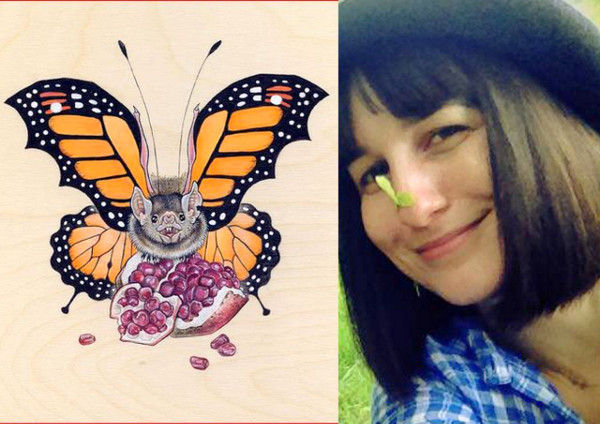
Some of you may have heard that Facebook recently shelled out the equivalent of $2 billion for Oculus Rift, a virtual reality headset. As CEO Mark Zuckerberg wrote:
The incredible thing about this technology is that you feel like you're actually present in another place with other people. Oculus's mission is to enable you to experience the impossible. Their technology opens up completely new kinds of experiences. Imagine enjoying a court side seat at a game, studying in a classroom of students and teachers from all over the world or consulting with a doctor face-to-face - just by putting on goggles in your home.
Initially designed by Palmer Luckey, Palmer describes how his goggles amplify the "matrix" of the visual stereoscopic display, (ie. your eyes), to let you really 'be in the game'.
Similarly, Sony, makers of the top-selling PlayStation 4, have also rolled out Project Morpheus, a virtual reality system. It pairs up with its popular gaming console to immerse players in the virtual worlds in which they're playing.
Recent demos at the Gamer Developers Conference in San Francisco included virtual immersion in a shark tank, intense sword playing and simulated dogfights in outer space.
Hmmmm. Something seems to bit awry with this pumped-up billion dollar 'virtual reality' vision. Something is definitely missing. What is it? In a word: women.
In a digital world increasingly designed by male software developers hell-bent on re-defining the parameters of their experience and existence, they seemed to have bypassed this essential element of humanity.
Women, if they are included at all, are generally depicted as voluptuous 'sex bitches' that either blow up things or are blown up. Most often the demos, games and current virtual realities are ultraviolent, pathetically stereotypical, and frankly, very very depressing - from a woman's point of view.
Current virtual reality is not very welcoming to thoughtful gentle women. And, equally, there's little room for an evolving female psyche ...
With these thoughts in mind, I would like to introduce you to an inventive, playfully serious, young woman, who, through her delicate somewhat macabre art, is challenging the threshold of these current mass-market male virtual realities.
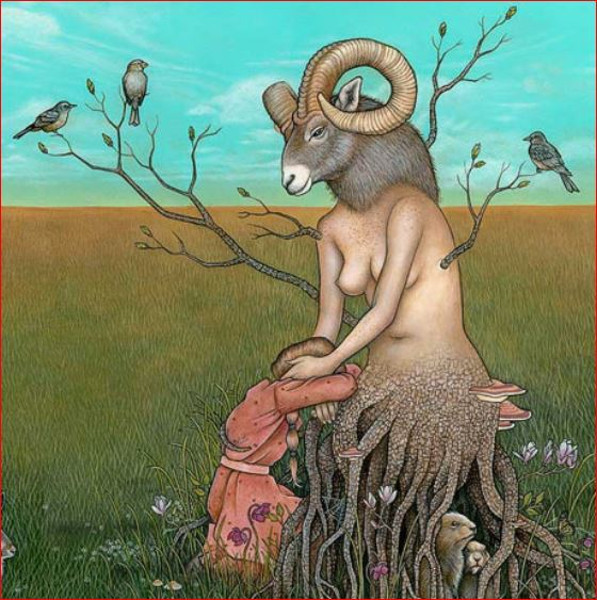
In essence, Tara Krebs is pitting her quixotic and compassionate imagination against the brutish dominating male matrix. It's all about power. Yes it is. It is about personal transformative - and formative - power. The power that makes us who we are.
Welcome to Tara Krebs' imagination.
What she is producing is not familiar, and yet, it is oddly known. She cleverly articulates strains of conventional ideas and infuses them with contemporary realities that cumulatively force you to re-consider our constructed worlds of childhood, memory and our commonly held natural environment.
All this is accomplished without billion dollar gadgetry. Participation and engagement are achieved solely through the vehicle of your own imagination. Imagine that!
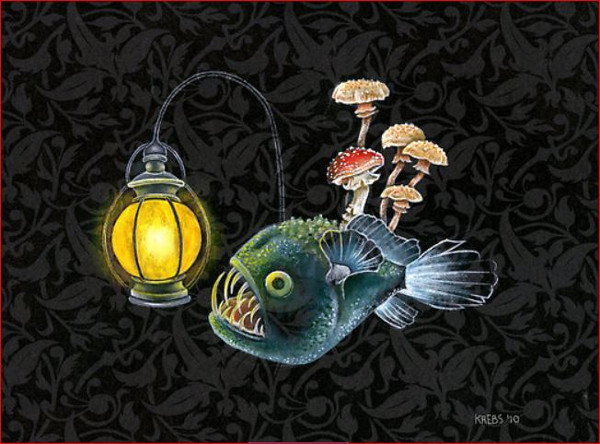
Merv
I was first introduced to her artworks at the now closed Manta Gallery, in a show entitled 'Tree Wolf and Other Stories', in November of 2012. Long after this fact, her works have wormed their way into my bouncing consciousness.
Her provocative visual narratives unsettle in their pointed exactitude. In other words, her art continues to work its irrefutable magic in our imaginations long after you've seen it. This is a remarkable talent and a Gift - and also a kind of game that Ms. Krebs continues to play with her growing fan base.
So who is she, where did she come from? How has she become the artist that she is? Tara Krebs was born in 1985. She began life in the small suburb of Thornhill, north of Toronto.
Tara Krebs (TK): I come from a pretty huge family, and we were all creative in different ways. My sister, Heather, is also an artist, and the rest of my six siblings were all involved in arsty things, be it music, dance, school plays, or what-have-you. Being in a big family is loud and crazy and fun and insane, which I think is a perfect environment for creativity to blossom because there's so much material. My mom was always reminding us to have confidence in ourselves and to try different things, so there was a lot of room for exploration. Although, I think she'd admit that she was encouraging us to pursue the arts more as a hobby than a profession .. Oops."
Margaret Lindsay Holton (MLH): Describe an early moment of 'artistic discovery' that launched you ...
TK: I actually have a vivid memory from kindergarten where I was drawing a person with a pencil crayon and all of a sudden I thought to myself "Wait a minute ... Hands aren't sticks. They're curvy and made of matter and have thickness to them." That was a important moment for me. It's probably where I began more fully analyzing the world around me visually, and really looking at what things are.
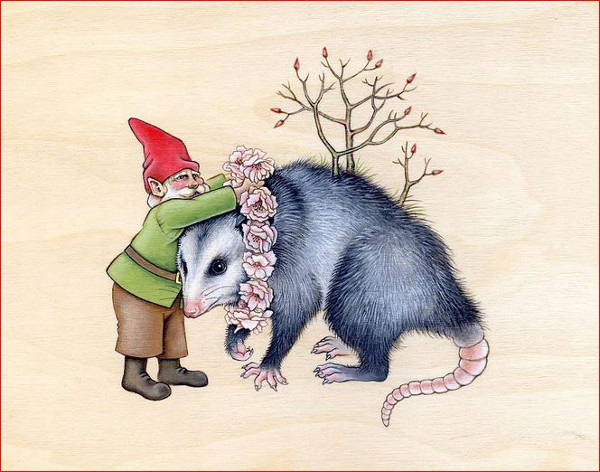
Spring
MLH: What about high school teacher influences? How did they impact your decision to go on to art school?
TK: I had a couple of art teachers before university that were definitely very influential to me. One was my elementary school art teacher, Mrs. Lottering, who gave me special projects when she felt as though my skill was beyond what the assignment required. The other was my high school teacher, Mr. Sevier, who told me "trees aren't brown and green", an invaluable piece of advice I share with others to this day. Teaching environments can be very bland and mundane, especially for someone like me who sees the world in IMAX. I consider myself very lucky to have been taught by people who were/are both such interesting, funny, and engaging people that clearly cared about their students and brought life and character to their classrooms.
MLH: Any specific reason for choosing OCAD (Ontario College of Art & Design)? Who and/or how did that training shape your philosophy about the making of art?
TK: Going to a school devoted completely to art was an exciting notion for me, as was studying in the heart of the city, after spending much of my young life stuck in suburbia. So OCAD was a natural choice for me. One of the struggles of being an art student is that you have to find the balance between staying true to who you are as an artist, but also being open to other peoples' opinions and criticism about your work (some of whom will be grading you on said projects!) I felt a lot of pressure in some classes to move away from what felt right to me as an artist. And as a result, I spent a lot of my post-secondary education feeling less enthusiastic about making art.
This led me to take a breather after graduation, teaching art to others but not making much myself. When I started drawing and painting again a few years later, it was the sort of subject matter that I'd been encouraged to steer away from that I became really successful at. So coming out of art school I didn't feel like I learned a ton that really shaped me into the artist I am today, but I got to interact with a lot of great professors and students and hear their own philosophies, and just be around that energy which I think is really important and totally inspiring. Also, that cute guy in my sculpture class (aka Cute Sculpture Class Guy) ended up being my partner of seven years. So stay in school kids. Ya never know! :)
Sidenote: Tara Krebs graduated, with Distinction, with a Bachelor of Fine Arts, in 2007. Now to dig in, and to give you a sense how this talented creative really thinks, consider her artist statement for her graduating thesis, entitled Cheesecake Theology. The nuance, deliberation and thought-filled incisiveness will - and should - spin your head.

TK: The inspiration for my thesis work comes largely from my own love affair with mythology and fantasy, as well as a deep interest in the human condition. It is this interest in and constant exploration of these two topics that have led to the realization that they are very much intertwined.
For this body of work, I have examined the way art has long been used as an effective tool for education, persuasion, promotion, and propaganda. This can be seen in the theatrical works of art commissioned by The Church with the purpose of drawing in the masses and appealing to the illiterate. In this modern era, the universal language of art is largely utilized by the media, although these days the predominant theme within the images is usually "sex sells."
This evolution of art persuasion has led me to wonder how the constant campaign for religion could be combined with our modern preoccupation with sexuality. If religions gave in to the theme of "sex sells" to try to lure in new practitioners, what would this look like? If female religious characters of various observances could be acceptably seen as sexy, fun, or downright dangerous, could their corresponding faith reach out to a broader audience?
To convey this idea, I've combined several female characters from various religions with the imagery of classic 30's-50's pin up art. The sensual and divine figures are subject to the same admiration or criticism that a regular pin up would receive. When one looks at the paintings, they are asked to question what they know about worship, female roles in religion, as well as who holds the power; the voyeur or the viewed.
Men and women alike have long worshiped and tacked up sexualized imagery in their work and living spaces much in the same way religious people worship statues and framed pictures of their Gods in their homes. What does this say about the human mind? What does it say about our views toward the opposite sex, separately and in correlation with our religion?
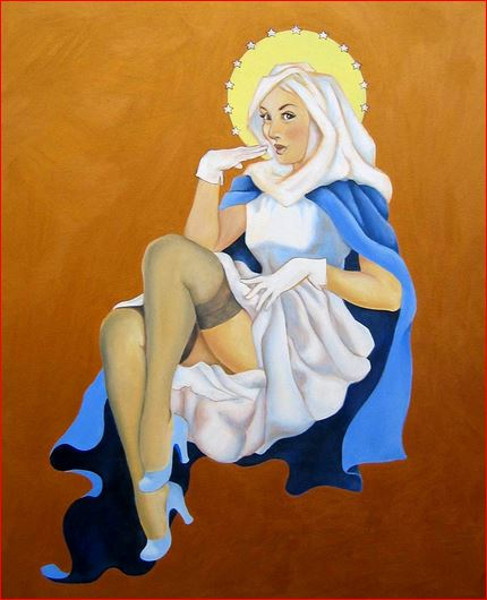
Virgin Mary
MLH: Your Cheesecake Theology seems like a prelude to a much more ambitious work. ie. How have the surrounding myths and mythology of Canadian politics started to shape your recent works, like 'On Guard for Thee'?
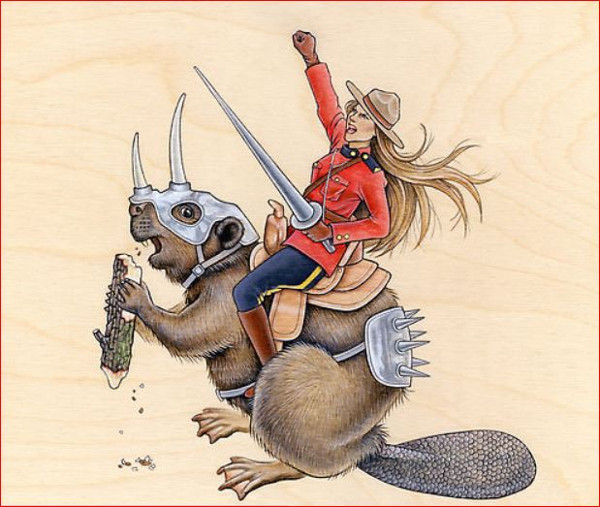
On Guard for Thee
TK: Cheescake Theology was an important project for me, because it was the first time I'd done such a large, cohesive body of work, and something that was so revealing and potentially offensive to someone who didn't understand it. I think that in some part it affected my confidence to express deeper, more challenging subject matter on a larger scale. It's a topic I'd like to get back into some day. But during my break from art, I did a lot of traveling for a few years, and when I returned, I felt hungry to get back to the sort of images that felt more natural to me all along.
My Canadian-inspired paintings and patterns weren't so much based on Canadian politics, but rather a fondness for Canadian nostalgia. I feel like in general, Canadians seem to have a good sense of humour about ourselves. I think it is defining to who we are as a country.
I've also noticed in recent years an incredible appreciation for nostalgia: not so much for a "look what we conquered" past that some other nations might cling to, but for simple things from our recent history, like the beauty of our land, a fondness for plaid, our "who's the big man now?" attitude on how we had chip flavours America didn't have, and how endearingly behind them we were on everything else. Complaining about the weather no matter what the weather was, making fun of our accents, and creepy puppet-led public service announcements telling us not to put things in our mouths, I love all that stuff.
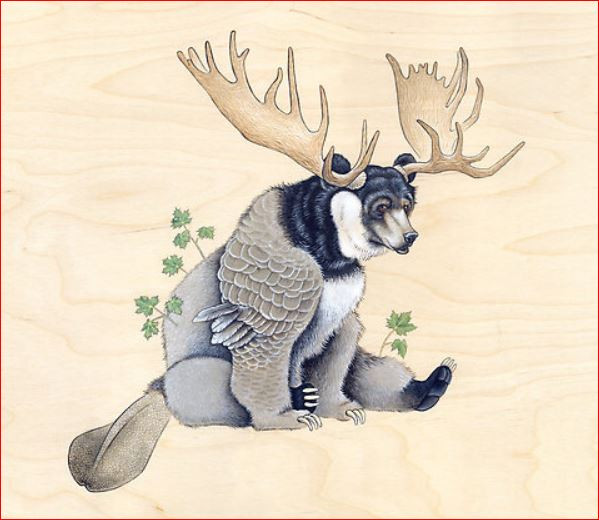
A Part of Our Heritage
MLH: You've been showing in California and LA a lot lately. Why not just mush along in Toronto, Ontario? What's there that WE should know about?
TK: California has a very strong new surrealism scene, and a lot of galleries involved in the genre. I love Toronto, and am interested in showing more in the GTA in the future, but there aren't as many galleries that exhibit that sort of work.
Sidenote: Pop Surrealism is one of the fastest growing art movements of today. First defined as Lowbrow by Juxtapoz Magazine in the early nineties, the movement was heavily influenced by underground comics, punk and rock music, vintage pinups, and the 1960s hot rod culture. Now, it's more about mass culture infused with a surreal or dreamy vision. Strangely, (or not?), women are most actively shaping this particular art sphere.
MLH: Reality swirls with fiction in your works, does fiction shape reality? (A bear is a bear is a bear, to paraphrase Gertrude Stein.) Pontificate.
TK: I think it goes both ways. I'm definitely influenced by the different fables and fairy tales I've heard in my life, but very much inspired by my own life experience as well, especially my memories of childhood and the worlds I could create and believe in so fully at the time.
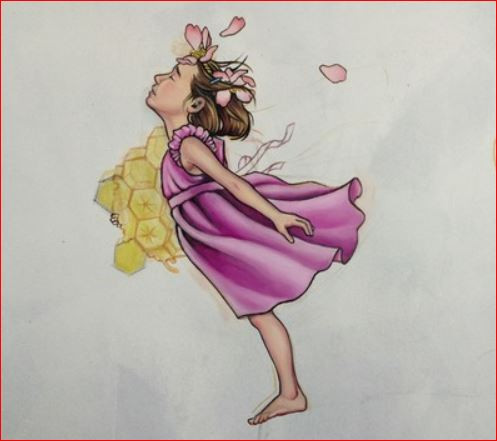
MLH: There's no conventional sci-fi 'alien' in your works, rather, it's the 'familiar' kind of warped out. How do these juxta-dis-associations clarify and shape your own evolving vision? Kindly give example of what works, and what doesn't.
TK: It's actually sort of funny, because I'm a huge sci-fi nerd, and I'm not sure why my work hasn't gone in that direction yet. Maybe it just seemed too obvious. More than anything though, I really have a Love for Nature. I've long believed that the world is just one big organism, and all the different little lives on it are gears that keep that organism functioning. That idea is really difficult for some people to believe.
I'm not really sure why because our bodies are just smaller examples of the same concept. ... Think of a forest and its ecosystem and how the devastation or introduction of one species can throw off the whole balance. That forest is part of the world's body. If its "blood cells" are off or it has "injested" too much poison, it is sick, just like any living thing.
So, what if the world is one big creature and we're all just little amoebas and cells that are part of her body? That idea is explored through the merging of animals and plants in my work - the idea that we are all connected by the same energy and as such, are really, one.
In terms of what works and what doesn't, I'm not sure. Once I get one piece out of my brain, I'm on to the next and try not to think about it too much after that, because I can get really obsessed about how I could have done things differently. I'm still learning and changing all the time.
MLH: Finally, how do you see yourself and your work 20 years from now? Where will you be, what will you be doing?
TK: It's hard to say, because life is full of so many variables. If I had a little window into my future, even I might be surprised to see where my path has led. In the last year, my ideas have definitely evolved from the specific style and themes you might know me for, but I'm still working on my solo show work, so to keep all the pieces for this exhibition uniform, I've had to sort of stifle those urges to explore new things. That said, I'm really happy with this new project. But I'm also excited to just play and try out new stuff when it's done and get my new ideas down on paper, wood and board.
Tara Krebs' next solo show, A Perilous Journey, opens August 16 in San Francisco, California, at the (somewhat appropriately) Modern Eden Gallery.
It is possible to procure prints of her engaging works, at very reasonable prices, via Red Bubble or via Etsy.
One to watch: Tara Krebs.
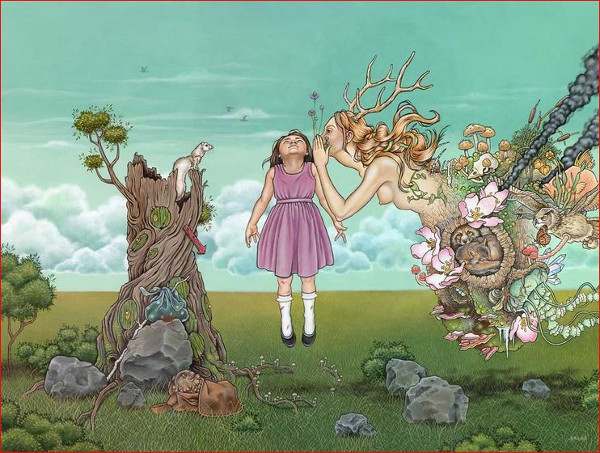
The Secret by Tara Krebs
By missy2013 (registered) - website | Posted March 28, 2014 at 10:46:40
Afterthought: After I filed this interview, I quite co-incidentally stumbled on another example to illustrate the growing dichotomy ...
'Starhawk', as many guys know, is an high-octane virtual reality game that encourages players to blow up as much as possible. Review the video clip here: http://us.playstation.com/games/starhawk...
Conversely, 'Starhawk' is also a well known American-based feminist within the burgeoning permaculture community. This video clip is long, 1:25 hours, but well worth a listen. http://www.hds.harvard.edu/multimedia/vi...
Question is: of these two opposing imaginative VISIONS that articulate humanity's strengths and weaknesses, which one, which direction, is most likely to create a better world that we can all live in?
By Pxtl (registered) - website | Posted March 28, 2014 at 10:56:58
... I'm kind of missing how griping about the gaming industry is relevant here. I totally agree that the industry has problems with its representation of women, but I don't quite get how it figures in here.
By Missy2013 (registered) - website | Posted March 28, 2014 at 14:08:38 in reply to Comment 99298
I think the operative word is 'compassion' ... Expanded in the comment below.
By missy2013 (registered) - website | Posted March 28, 2014 at 11:41:15
What I'm trying to get at is the 'use' of our human imagination. The gaming industry caters to - and cultivates - a stereotypical 'male psyche', one that is heavy on the violence & 'dominance'. It is shaping and has shaped male imaginations. The gaming sphere (amplified with newly devised 'goggles') deliberately cultivates a narcissistic extremist craving.
Billion dollar contrivances that are capturing and taking hold of the male mind in this way ultimately influence the rest of the world. Subsequently, this shaped 'mind set' trickles into societal interactions. It enters our politics, our sexual relations and our families. ... Consider that drones are now 'real'.
The opposition to this billion dollar imposition is, currently, quite small. But there are those who realize that this direction - this use of our human imagination - is really not that good for us, that this dominating exploitative over-bearing 'mind set' has got to change ...
Tara Krebs is a living example of a different kind of approach.
You must be logged in to comment.
There are no upcoming events right now.
Why not post one?